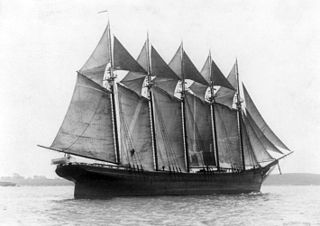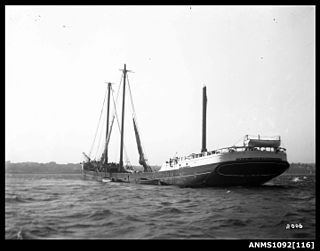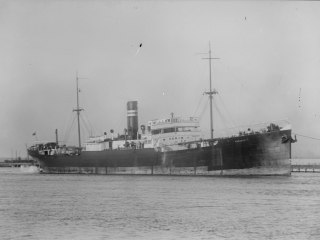
The Governor Ames was the first five-masted schooner. In the late 19th century, she was the world's largest cargo vessel.

Vatoa is an outlier of Fiji's Lau Group.

Port Blakely is a community of Bainbridge Island, Washington in the western United States. It is located on the east side of the island, slightly to the south. The center of Port Blakely is generally defined as the intersection of Blakely Hill Road and Blakely Avenue NE, although the wider area is generally also known as Port Blakely.
The West Coast lumber trade was a maritime trade route on the West Coast of the United States. It carried lumber from the coasts of Northern California, Oregon, and Washington mainly to the port of San Francisco. The trade included direct foreign shipment from ports of the Pacific Northwest and might include another product characteristic of the region, salmon, as in the schooner Henry Wilson sailing from Washington state for Australia with "around 500,000 feet of lumber and canned salmon" in 1918.

Boat Harbour is a small beach located on the southern side of the Botany Bay National Park in Kurnell, Sydney, New South Wales, Australia.
Metha Nelson was built as a wooden‑hulled merchant schooner which was later used in historic movies as a full-rigged ship. During World War II, she served the United States Navy.

Marlborough was an iron-built two-decked merchant sailing ship which disappeared in 1890. She was built by the firm of Robert Duncan and Co., Port Glasgow and launched in 1876. First managed by James Galbraith for the Albion Shipping Company, she was registered in 1880 to the ownership of John Leslie of London, while continuing to operate within the fleet of Albion Line. Marlborough disappeared during a voyage in January 1890, and has not been seen or heard from in over a century. Searches and investigations have yielded nothing conclusive, and the ship's ultimate fate, and that of her crew, remains unknown.
The Advance was a composite schooner built in 1874 at Auckland, New Zealand, that was wrecked when she drifted onto rocks at Henrys Head, Botany Bay, New South Wales, Australia, on 12 June 1902, whilst carrying ballast between Wollongong and Newcastle, New South Wales.

The Inca was "the first true five-masted schooner built on the West Coast."
Sam Cearns was a British ship-rigged sailing cargo ship and emigrant carrier, built in 1864. In 1871 she was wrecked near Tierra del Fuego after the crew members gallantly saved the crew of another windjammer Knight Errant.

Pitcairn was a schooner built in 1890 for the Seventh-day Adventist Church for use in missionary work in the South Pacific. After six missionary voyages, the schooner was sold in 1900 for commercial use, and renamed Florence S. She was lost by stranding on the island of Mindoro, Philippine Islands, on 17 October 1912.

The New Zealand Company was a 19th-century English company that played a key role in the colonisation of New Zealand. The company was formed to carry out the principles of systematic colonisation devised by Edward Gibbon Wakefield, who envisaged the creation of a new-model English society in the southern hemisphere. Under Wakefield's model, the colony would attract capitalists who would then have a ready supply of labour—migrant labourers who could not initially afford to be property owners, but who would have the expectation of one day buying land with their savings.

SS Canastota was a British-flagged, coal-burning, two-masted, steel screw, cargo steamer of 4,904 gross register tons (GRT) and 3,139 net register tons (NRT). Canastota was last seen on 13 June 1921, leaving Sydney bound for Wellington, New Zealand. Although almost forgotten today, Canastota's loss was a major news item, in Australia and New Zealand, during the second half of 1921.

SS Myola was a 655-ton screw steamer, 55 metres long, built in Middlesbrough in the United Kingdom. Myola, could unfurl sails on her two tall masts and gain a knot or so of additional speed when the wind suited.

Sixty-miler (60-miler) is the colloquial name for the ships that were used in the coastal coal trade of New South Wales, Australia. The sixty-milers delivered coal to Sydney from ports and ocean jetties to the north and south. The name refers to the approximate distance by sea; the distance, from the Hunter River mouth at Nobbys Head to the North Head of Sydney Harbour, is 64 nautical miles.
Queen Cristina was a steam cargo ship built in 1901 by the Northumberland Shipbuilding Co of Newcastle for Thomas Dunlop & Sons of Glasgow. The ship was designed and built for general cargo trade and spent her career doing tramp trade. She was the second ship named Queen Cristina in service with the Queen Line.

The Stone Fleet was the colloquial name for the small coastal ships that carried crushed-stone construction aggregate to Sydney from the Illawarra ports of Kiama and Shellharbour and the nearby ocean jetties at Bombo and Bass Point.

SS Canonbar was a steam cargo ship built in Ardrossan, Scotland in 1910 for the North Coast Steam Navigation Company, and used in the Australian coastal trade. During World War II, she was part of the US supply fleet in the Pacific Ocean. From 1949, she was Rosita, until 1960, when she was renamed Valiente. Under the name Kettara IV, she was sunk by shell fire off the Vietnamese coast in 1966, with the loss of her entire crew.
The SS Trebartha was a 4,597 GRT cargo carrying steamship built in 1920 by John Readhead & Sons Ltd of South Shields for the Hain Steamship Company. She was attacked by German aircraft on the 11th November and sank on the 12th November 1940.

Rock Davis (1833-1904) was a shipbuilder, mainly associated with his shipyard, the Rock Davis shipyard, colloquially known as 'the Big Shed', on Brisbane Water at Blackwall, New South Wales, Australia. After his death, the business of ship building was carried on by his second son, also Rock Davis. The shipyard constructed around 165 wooden-hulled vessels, between 1862 and 1913.
















